Hansol LCD B17BF-1 LCD Monitor User Manual 700T
Hansol LCD Inc. LCD Monitor 700T
Contents
- 1. users manual
- 2. usrs manual
users manual
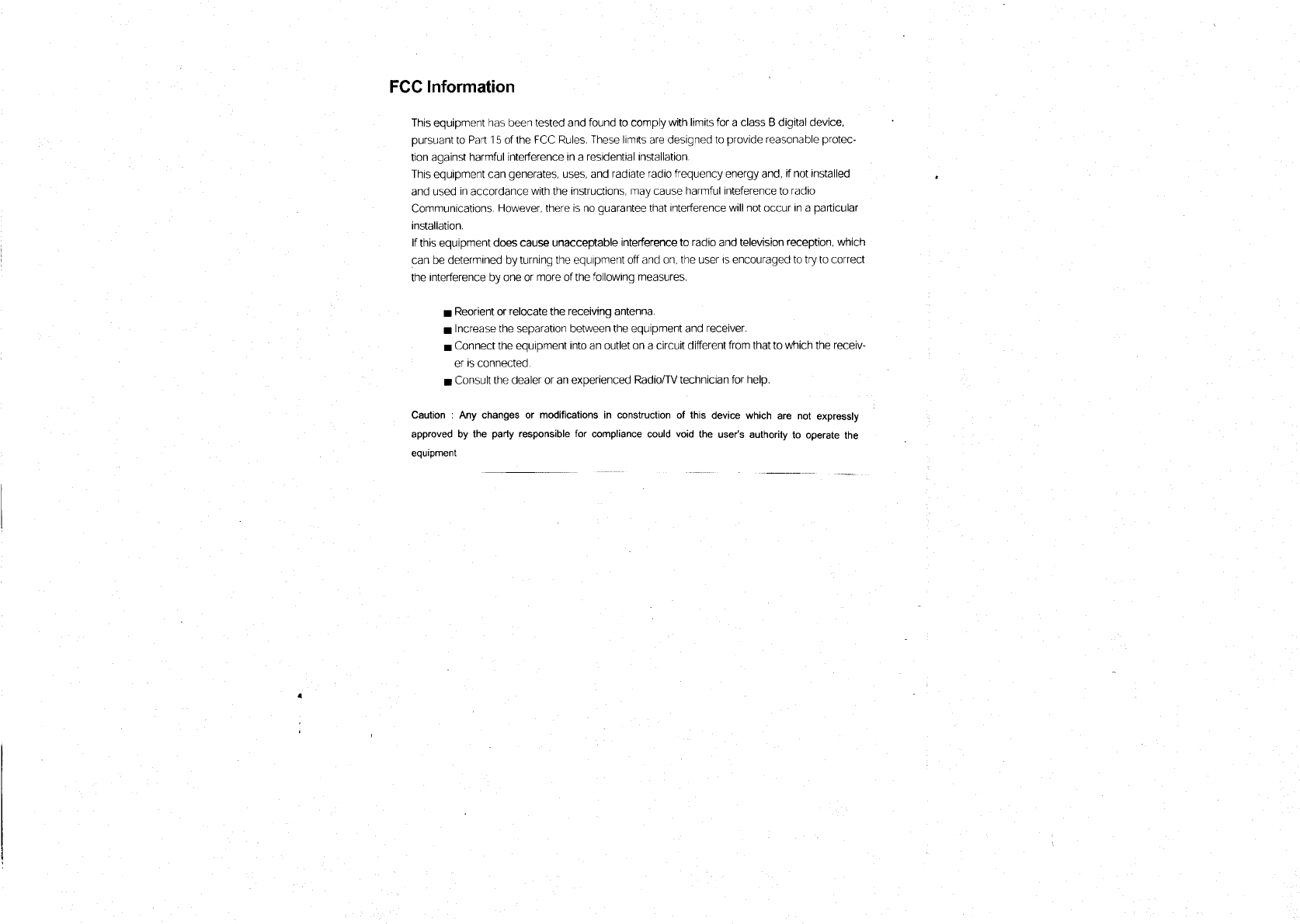

Parts 3
Connection to Computer 4
How to Adjust Monitor Angle 5
Installing Monitor Driver 6
Name and Function of Front Keys 8
Power Management Feature 10
PC Menu 11
Video Menu 15
TV 18
SOUND Menu 21
Configuration OSD Menu 23
Picture In Pincture(PIP) function 26
Remote Controller 27
Standard Signal Table 28
Specification 29
Troubleshooting 30
Warning 32
Table of Contents
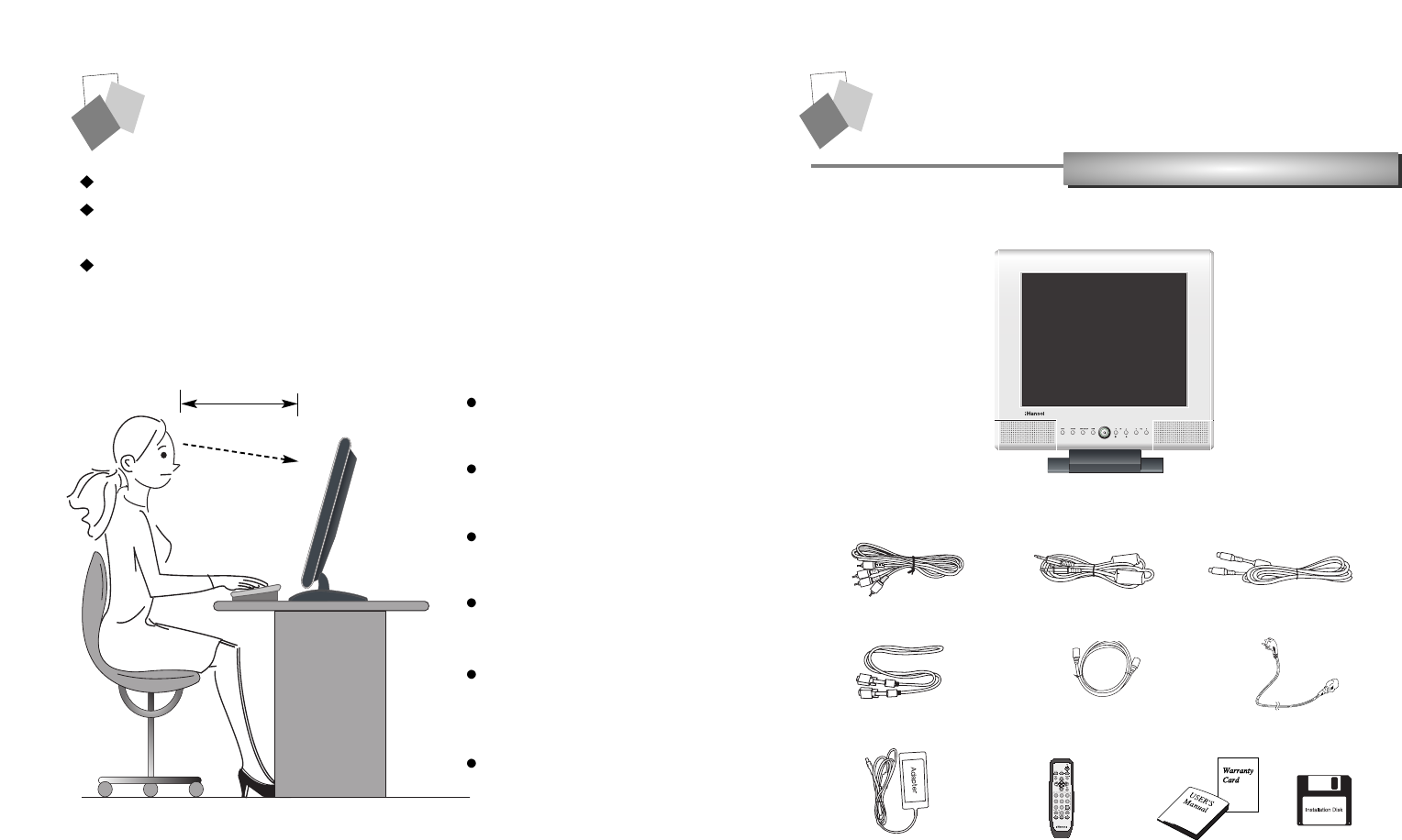
32
Parts
Parts
LCD Monitor
Place the monitor to face the user and then adjust the monitor angle.
Take a break (for about 10 minutes) at every hour during the work with
monitor.
Refer to the following figure to take the correct posture.
about 50cm
Look down the monitor
below the horizon.
Relax shoulders and arms,
and sit back on the chair.
Adjust the monitor to
prevent reflection.
Adjust the monitor stand
to acquire required angle.
Keep feet flat on the ground.
Maintain the arms horizontally
and place hands softly on
the keyboard.
Good Posture Guide
RCA Cable (Pair) Stereo Cable S-VHS Cable
12V-DC Adapter Remote
Controller/Battery User's Manual /
Warranty Card
Installation Diskette
Signal Cable Antenna Cable AC Power Cable
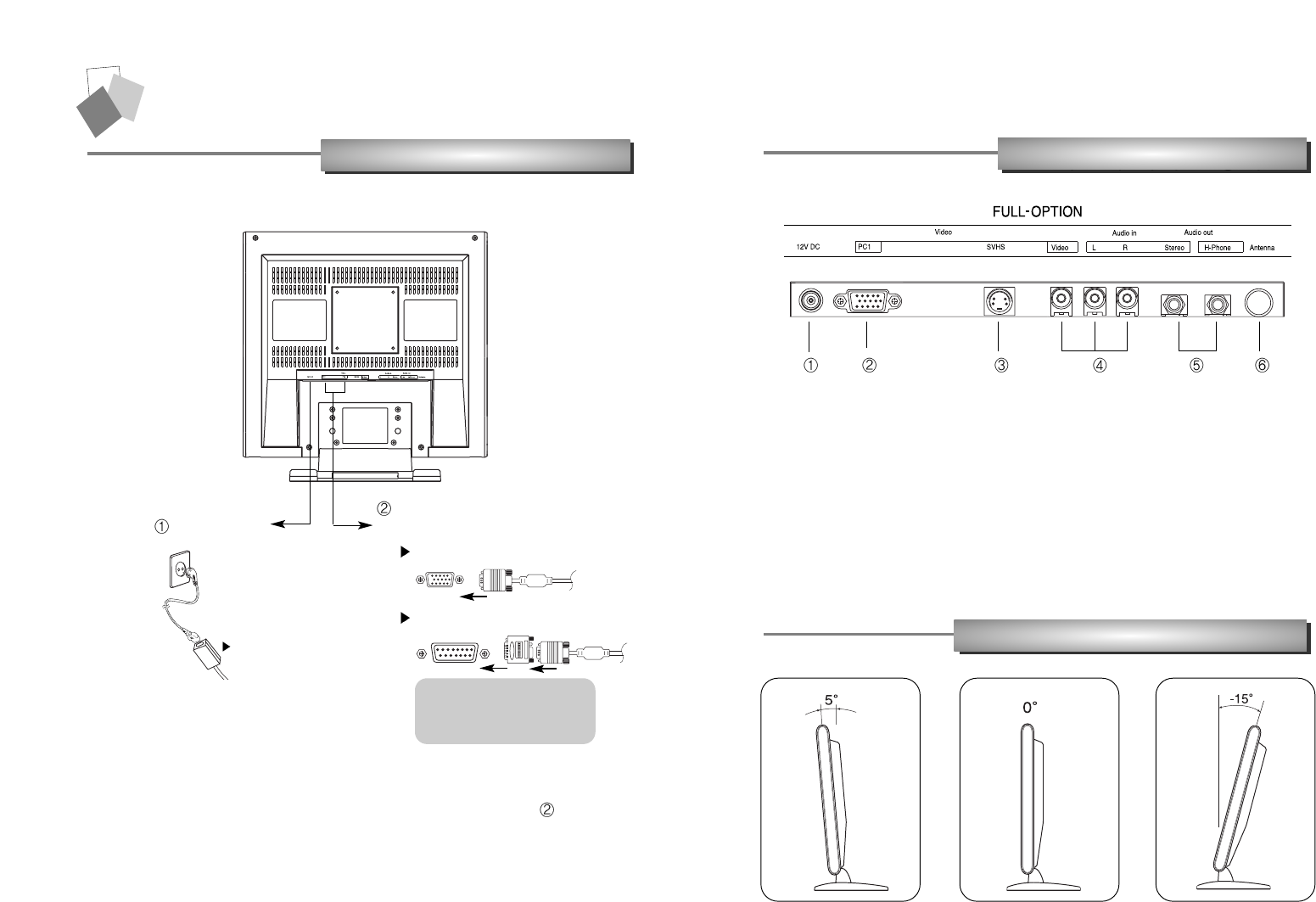
54
Applied Connection
How to Adjust monitor Angle
Connection to Computer
Basic Connection
1. Use 220 V or 110 V. (Free Voltage)
2. Connect monitor and computer via Signal cable (See figure )
3. Power on the monitor and computer.
1. Connect the adapter to "12V DC" input terminal.
2. Connect the computer cable to PC1.
3. Connect video (V1) connection cable or SVHS (V2) connection cable to
DVD, VCR or camcorder.
4. Connect audio output (computer, DVD, VCR or camcorder) to Audio In (L),
Audio In (R) or Audio In (Stereo).
5. Connect headphone or earphone to H-Phone terminal.
6. Connect antenna or CATV connection cable to "Antenna" terminal.
Port for
12V DC
cable from DC
adapter.
Port for
Signal cable
from Signal Source.
General
For Macintosh
In Usinga dapter.
Adapter for Macintosh (Optional)
Refer to the table on the rear side of
the optional Macintosh adapter and
adjust DIP switch by the resolution of
the monitor.
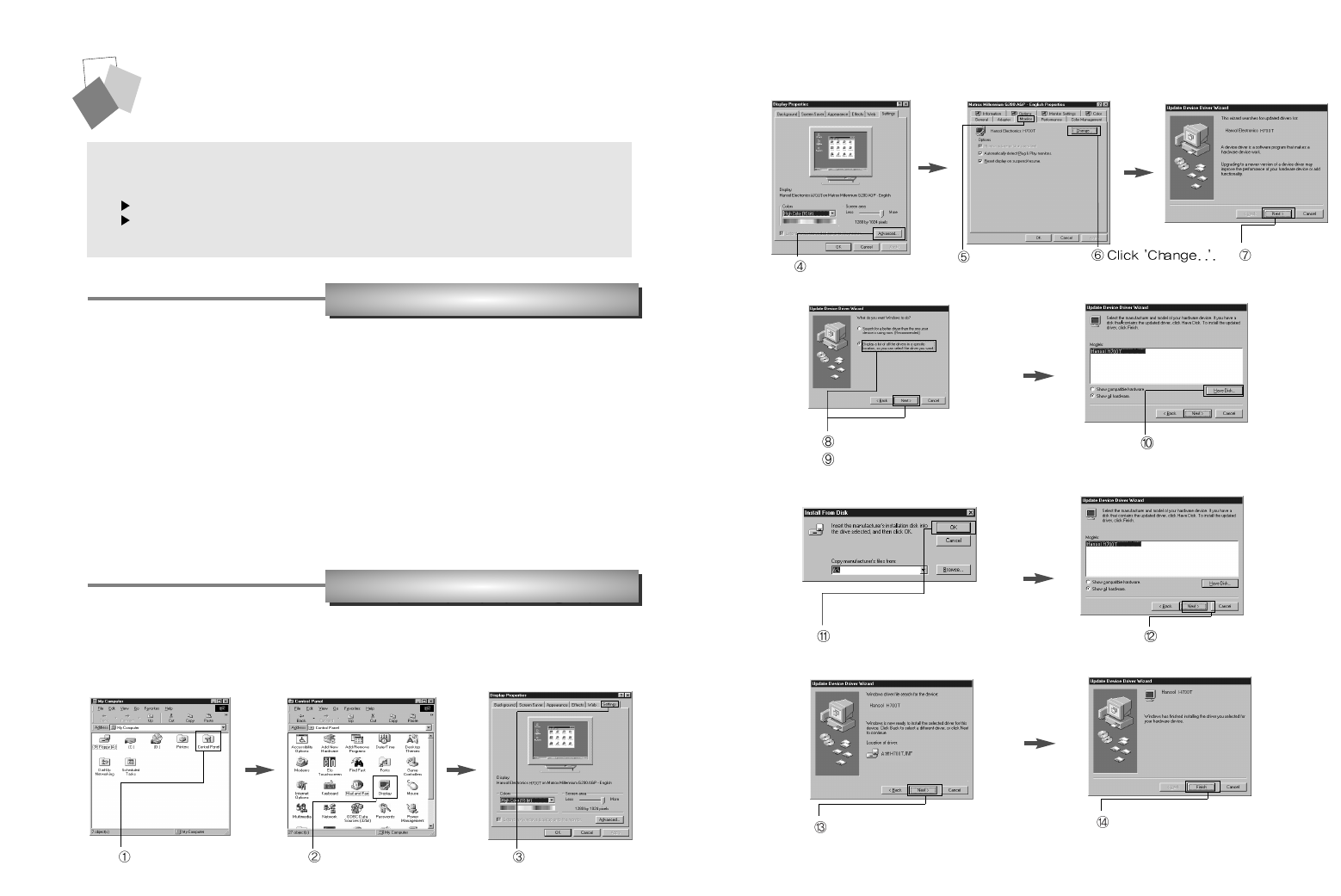
76
Click 'Finish'.
Click 'Next>'.
Click 'Advanced..'. Click 'Next>'.
Click 'Monitor'.
Click 'Display a list of all...'.
Click 'Next>'. Click 'Have Disk..'.
Select the driver and click 'OK'. Click 'Next>'.
3. Select Exit if the monitor model is changed, and then reboot Windows.
Installing Monitor Driver
1. Insert the CD in the CD-ROM driver.
2. "Installation Manager" window appears.
(Or, double-click Install.exe in the CD-ROM driver folder using search function.)
3. Click "Driver Installation" icon.
4. Select the model and click "OK".
5. Select inf file of the model in the Drivers folder in CD-ROM driver, and then click
"OK" button.
6. Click "Exit" to close the installation.
Automatic Installation
Manual Installation
1. Insert the CD in the CD-ROM driver.
2. Click 'My Computer' and follow the procedure below.
Click 'Control Panel'. Click 'Display'. Click 'Settings'.
Run (Click) Install at CD-ROM driver and select the product model to set the optimum
display in Window 95 or 98.
Use the Driver CD provided.
Download the latest driver from home page of Hansol Electronics Inc.
(http://www.hansolel.co.kr).
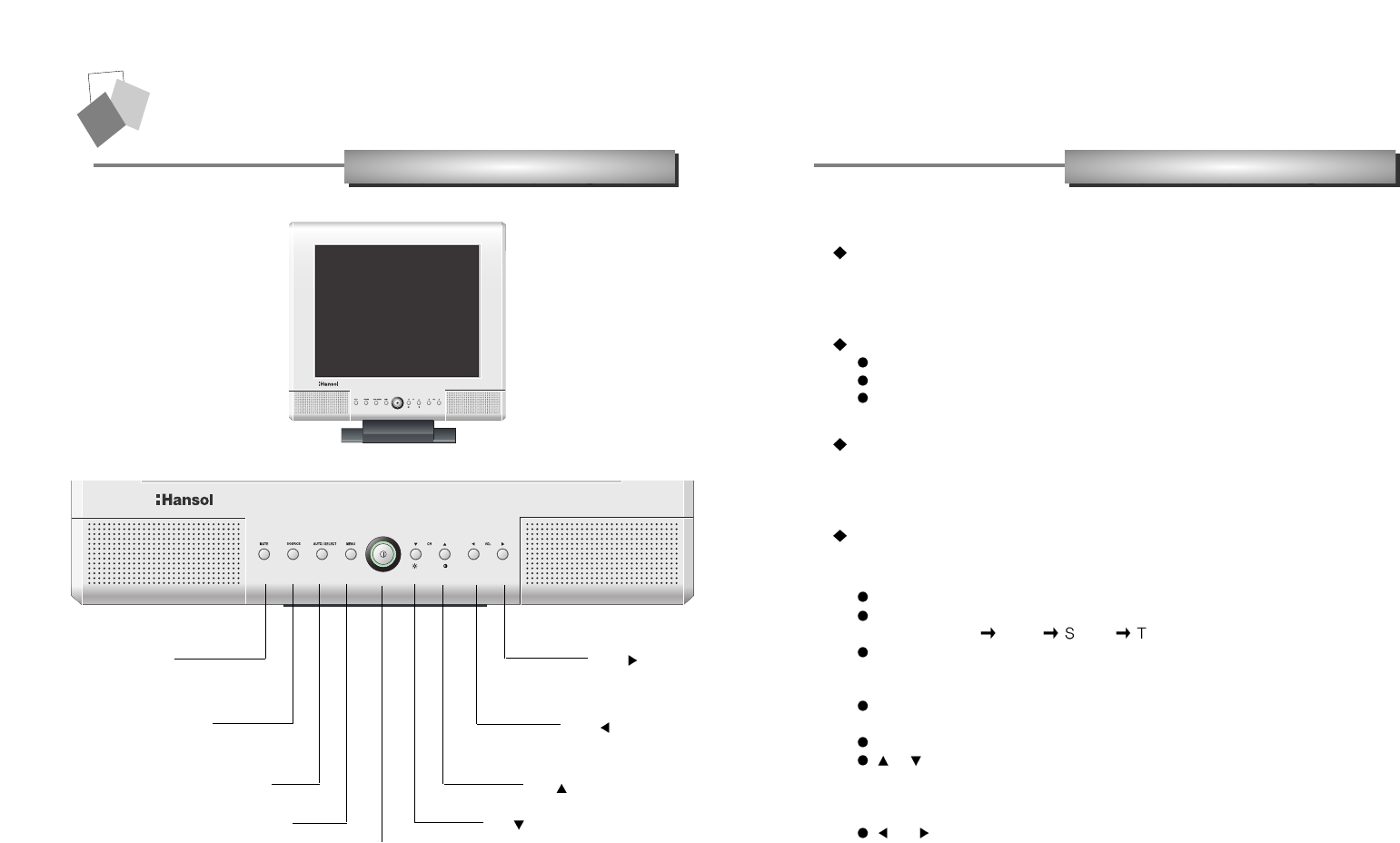
98
Functions
Name and Function of Front Keys
Front panel
MUTE
KEY
SOURCE
KEY
AUTO/SELECT
KEY
MENU
KEY
VOL
KEY
VOL
KEY
CH
KEY
CH
KEY
POWER
KEY
Power Switch
Power switch is located in the lower center of the monitor stand.
You can push the switch to turn on/off the power.
Power Saving LED
Dark : Power off
Green : Normal mode
Green blinking : Power Saving mode or check signal Cable mode.
Signal Source LED
Each of the five LEDs (from left; PC1, PC2, TV, V1 and V2) over the power
switch indicates the source of the signal which the monitor displays.
On Screen Display (OSD) Function Button
OSD buttons on the front of the monitor perform the following functions.
MUTE : Cut off sound
SOURCE : monitor displays source of the signal in order.
(PC
VIDEO VIDEO V)
AUTO/SELECT : Press this button, when OSD is not displayed, to perform
automatic setting. If you press this button when OSD is
displayed, you can select icons.
MENU : Press this button to display menus. if you press this button when OSD is
displayed, You can switch display to the previous menu and exit menu.
POWER : Power switch.
CH : Press this button to select TV channel in TV mode when OSD is not
displayed. Or press the button, when OSD is displayed, to move the
cursor into the menus which you want. when OSD is not displayed, you
can adjust brightness or contrast in PC/VIDEO mode.
VOL : Press this button to adjust volume of audio when OSD is not displayed.
By pressing this button when OSD is displayed, you can move cursor
into the menus or change gate level.
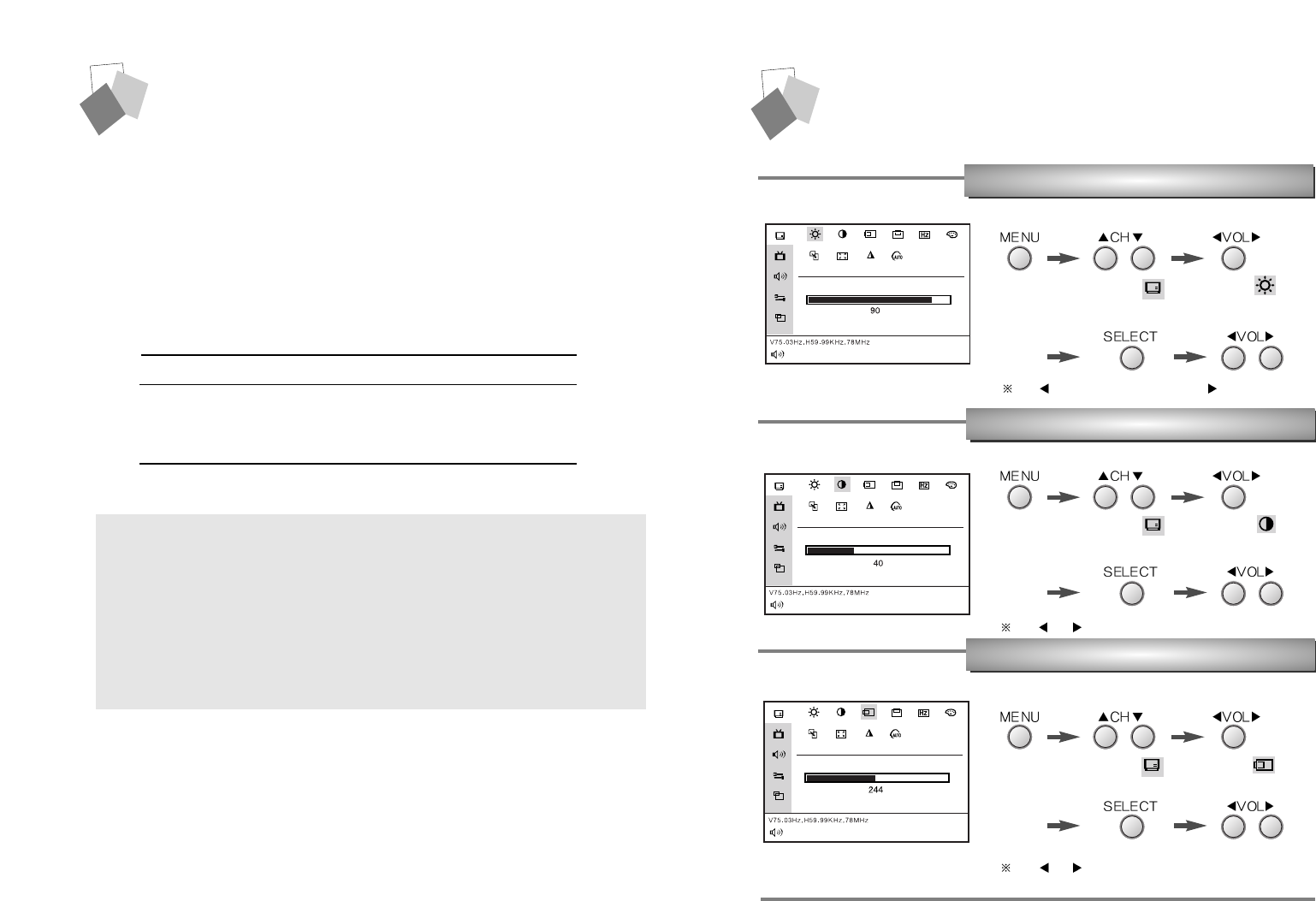
11
PC MENU
Brightness
Contrast
Horizontal Position
10
No image is displayed with LED blinking.
Monitor is in power saving mode.
Use mouse or keyboard to release power saving mode.
No image is displayed without LED on.
Power cable plug must be pulled out.
Check the power plugs on monitor and on the wall.
Power Management Feature
When not in use for a long period of time, the monitor
automatically reduces its power consumption, meeting power
saving standards of EPA and NUTEK.
The monitor is equipped with a power saving circuit that
conforms to the world-standard Display Power Manager
Signalling (DPMS) mode of Video Electronics Standard
Association (VESA).
The power management feature requires that the video card
of the computer should support DPMS function.
Status LED Sign Power Consumption
Normal Normal Power
DPMS mode Green Blinking 5 W or Below
Move to Move to
Move to Move to
Move to Move to
Use to have the monitor darker, to brighter.
Use or to adjust contrast.
Use or to adjust display left or right.
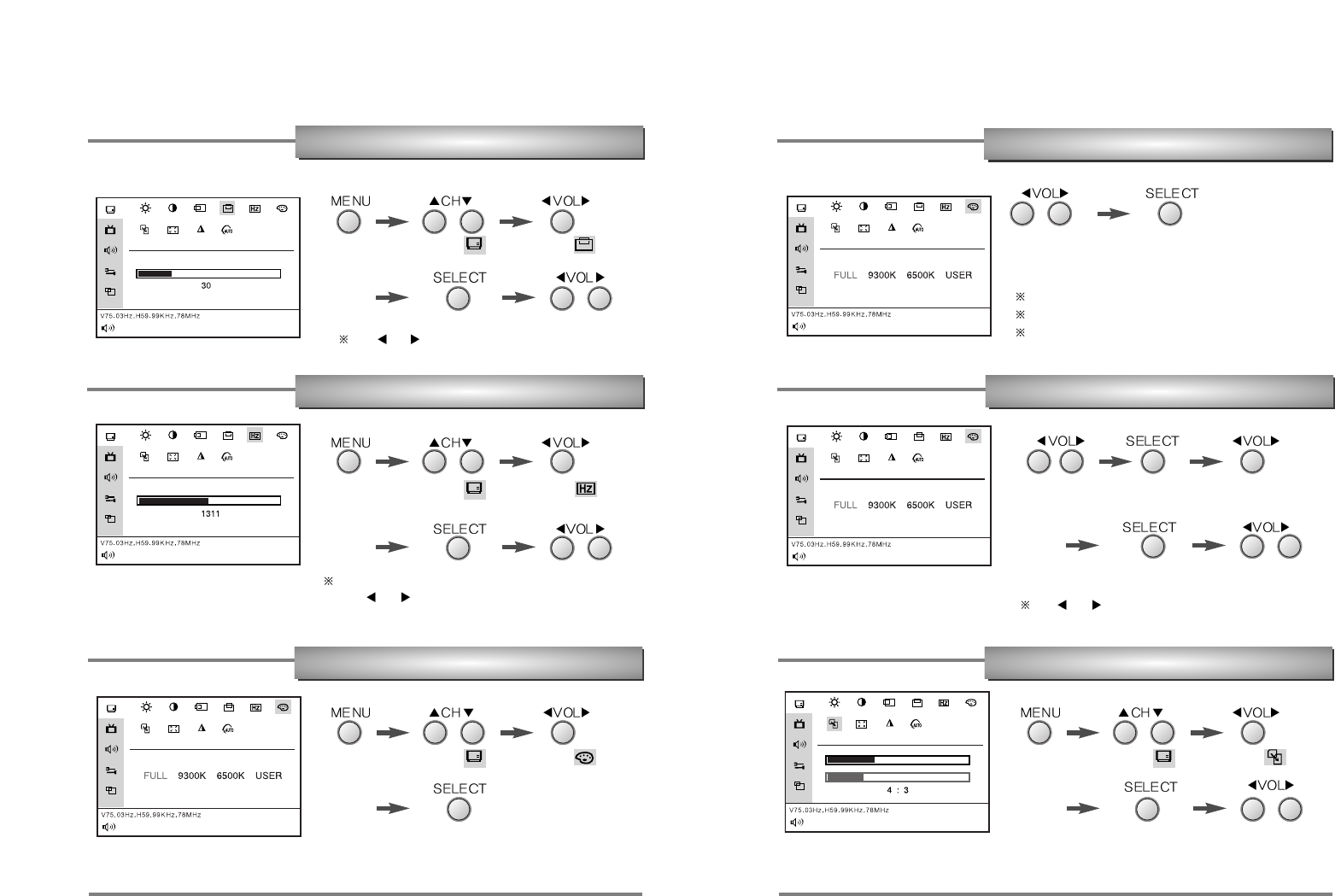
1312
Vertical Position
Clock
Color
Preset Color
User Color
Scaling
Move to Move to
Move to Move to
Move to Move to
Move to
"FULL,9300K,6500K"
Move to Move to
Move to Move to
Use or to adjust display upward or downward.
If Auto Adjustment function fails to remove video noise,
Use or to remove vertical noise.
(Adjusting phase is required after the adjustment of
Pixel Frequency.)
FULL : Red, Green, Blue full
9300K : Bluish white
6500K : Reddish white
Use or to increase or decrease each color.
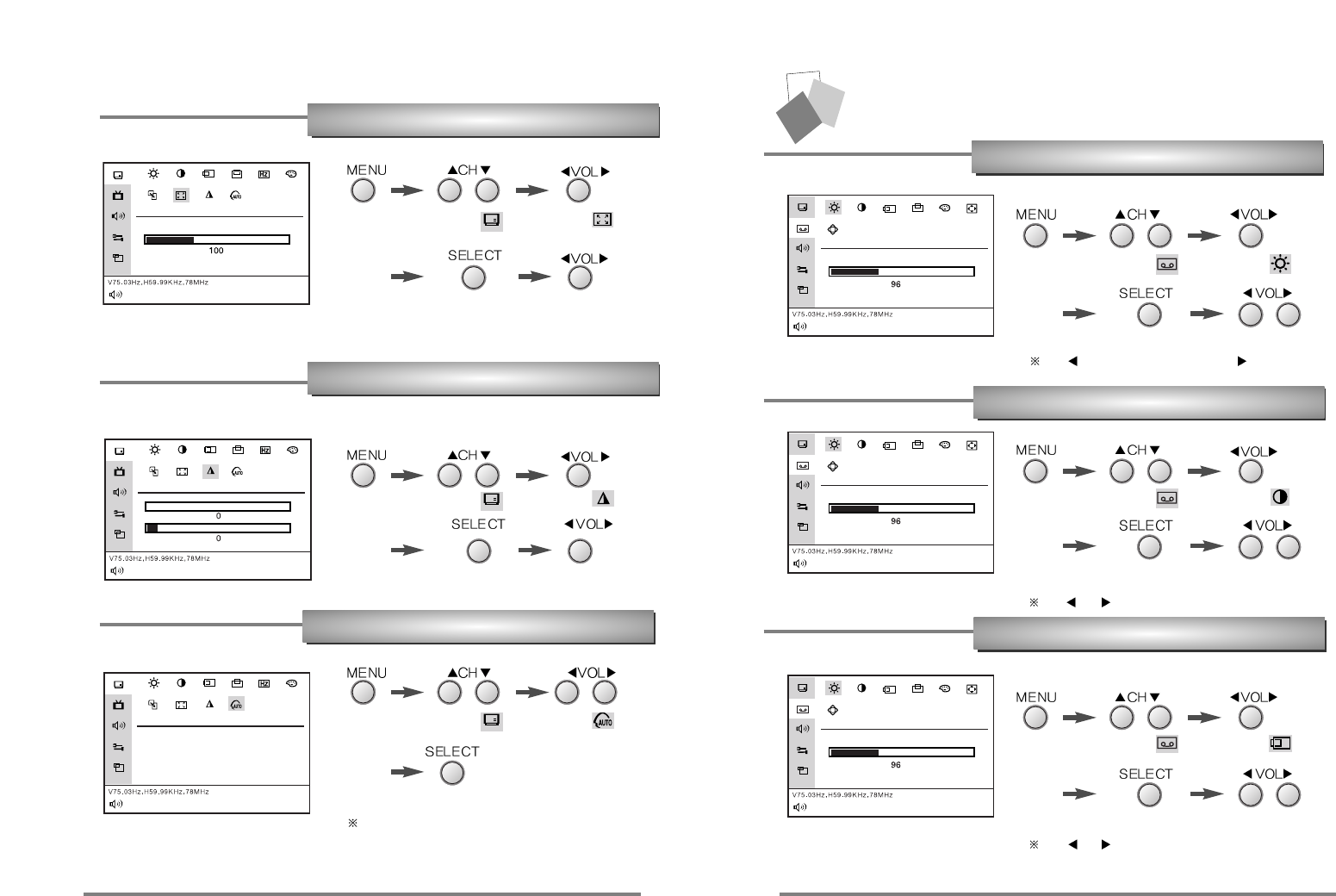
1514
ZOOM
Sharpness/Phase
Auto - config
Video Menu
Brightness
Contrast
Horizontal Position
Move to Move to
Move to Move to
Move to Move to
Move to Move to
Move to Move to
Move to Move to
In most cases,AUTO ADJUSTMENT adjusts display
appropriately. Use PHASE or adjust PIXEL FREQ In
accordance with graphic card to fine tune the display.
Use to have the monitor darker, to brighter.
Use or to adjust contrast.
Use or to adjust display left or right.
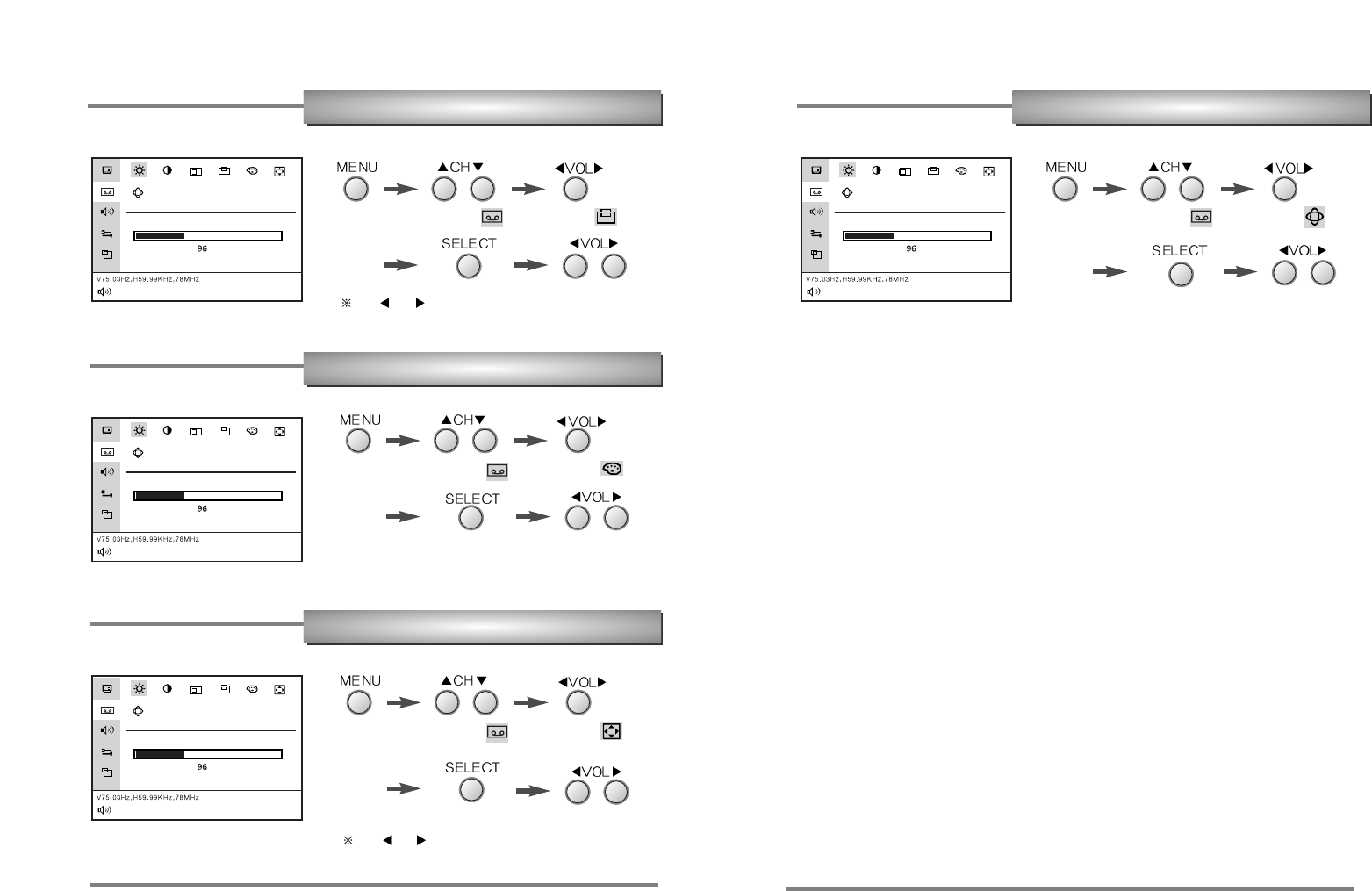
1716
Hue/Saturation
PIP Position
Vertical Position Sharpness
Move to Move to
Move to Move to
Move to Move to
Move to Move to
Use or to adjust display upward or downward.
Use or to adjust PIP position.
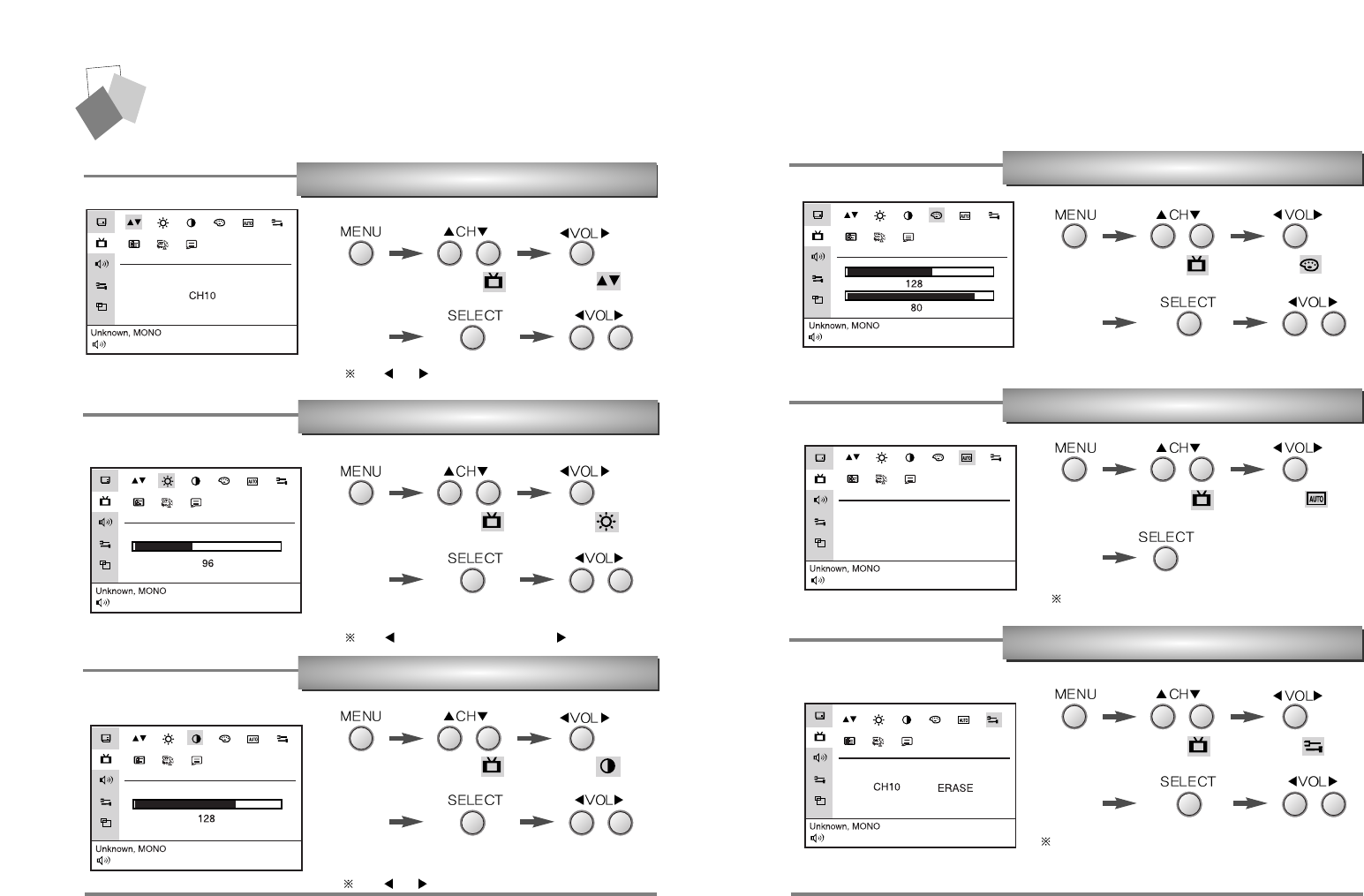
1918
Hue/Saturation
Auto Channel Search
Select Configuration
Contrast
Channel
Brightness
TV
Move to Move to
Move to Move to
Move to Move to
Move to Move to
Move to Move to
Move to Move to
Use to have the monitor darker, to brighter.
Use or to adjust contrast.
Use or to select channel.
Channel is searched automatically and saved.
When signal is weak or the channel is not used for
broadcasting, it is available to add or delete the
channel.
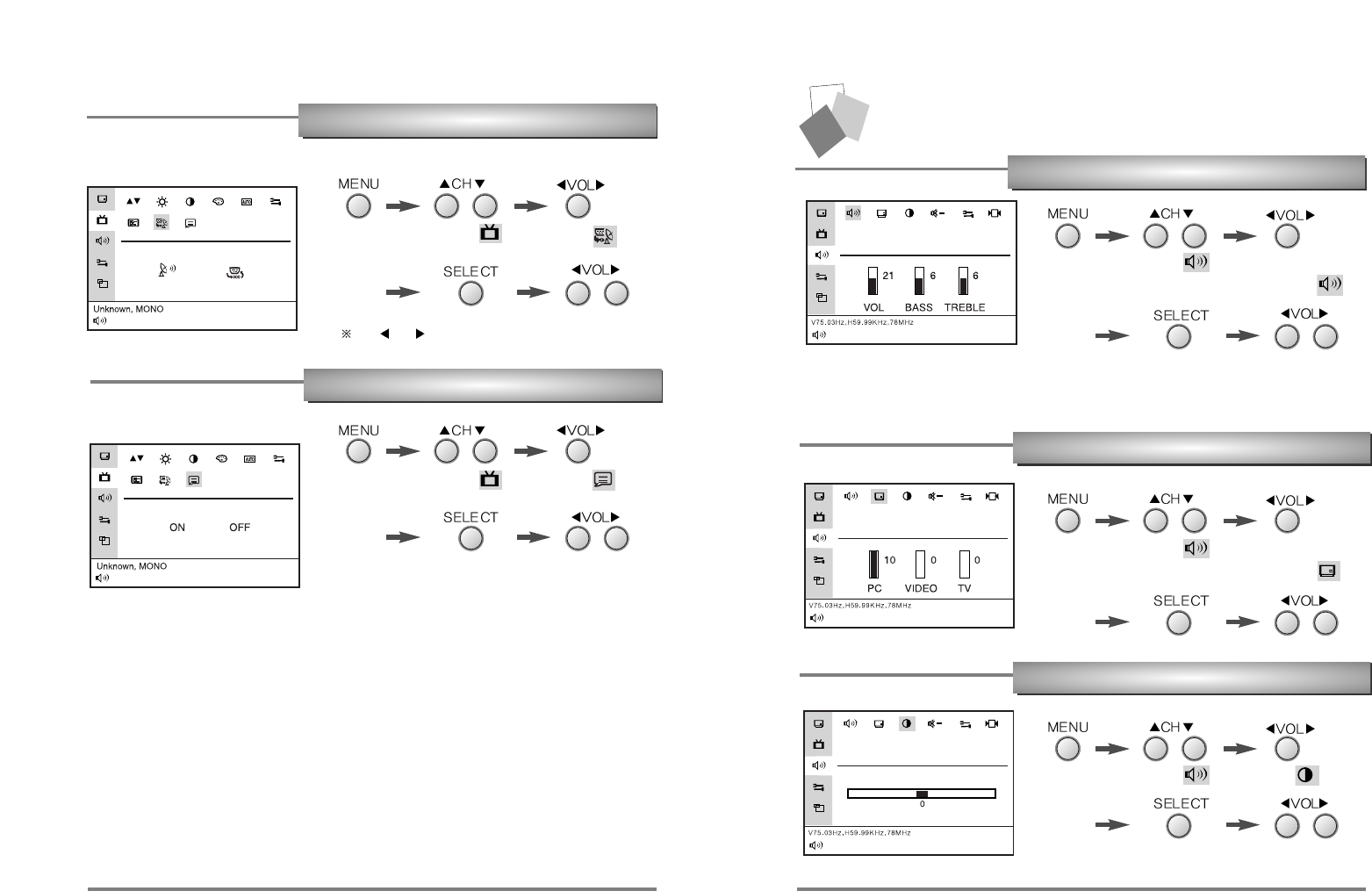
2120
Broadcast type
Caption
Sound Control
Sound Balence
Speaker Balence
SOUND Menu
Move to Move to
Move to Move to
Move to Move to VOL, BASS,
TREBLE at
Move to PC,
VIDEO, TV at
Move to
Move to Move to
Use or to select cable/air.
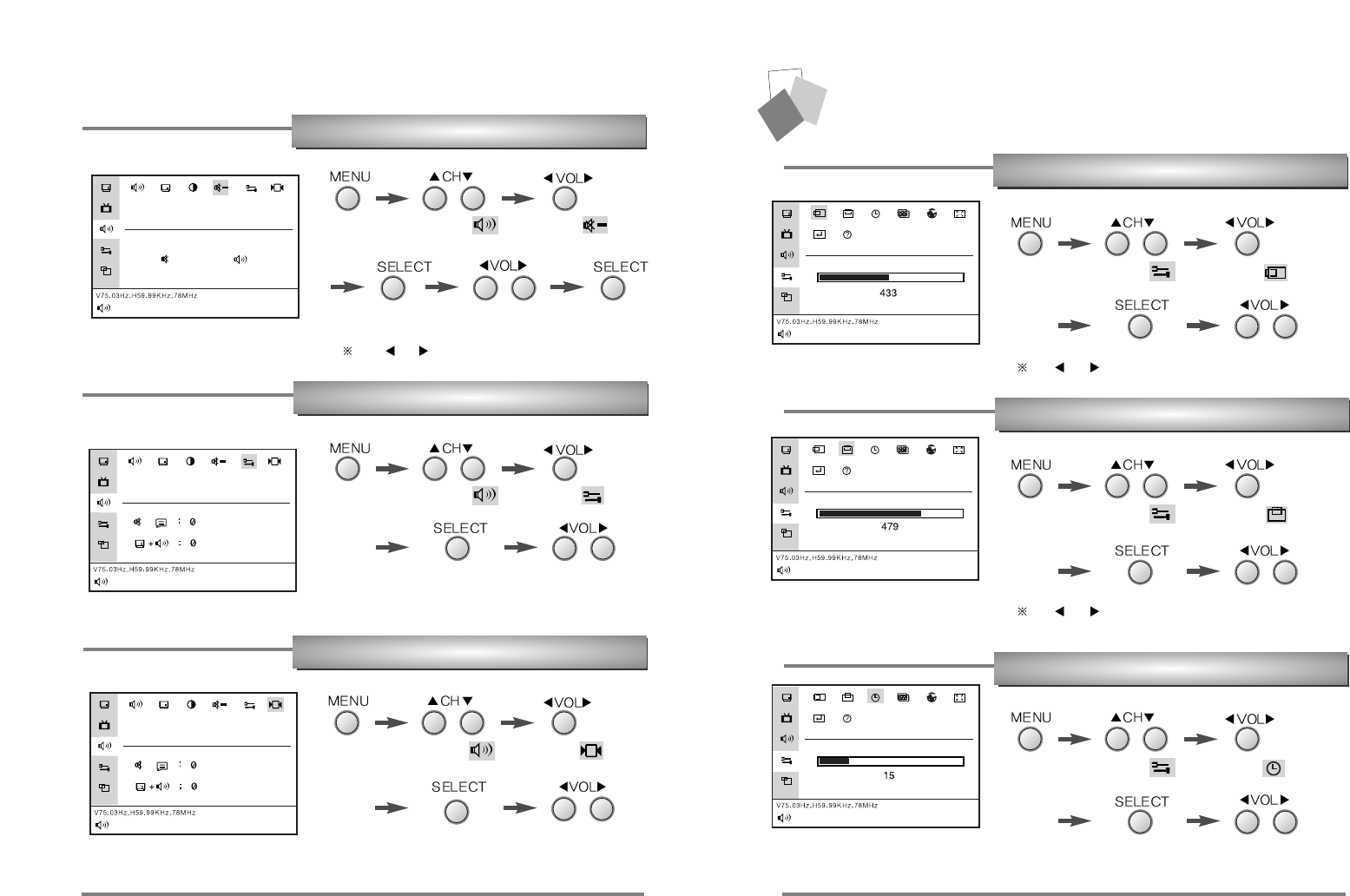
2322
Mute
Config Control
SAP
OSD H-Position
OSD V-Position
OSD On Time
Configuration OSD Menu
Move to Move to
Move to Move to
Move to Move to
Move to Move to
Move to Move to
Move to Move to
Use or to Sound On/Off. Use or to adjust OSDleft or right.
Use or to adjust display upward or downward.
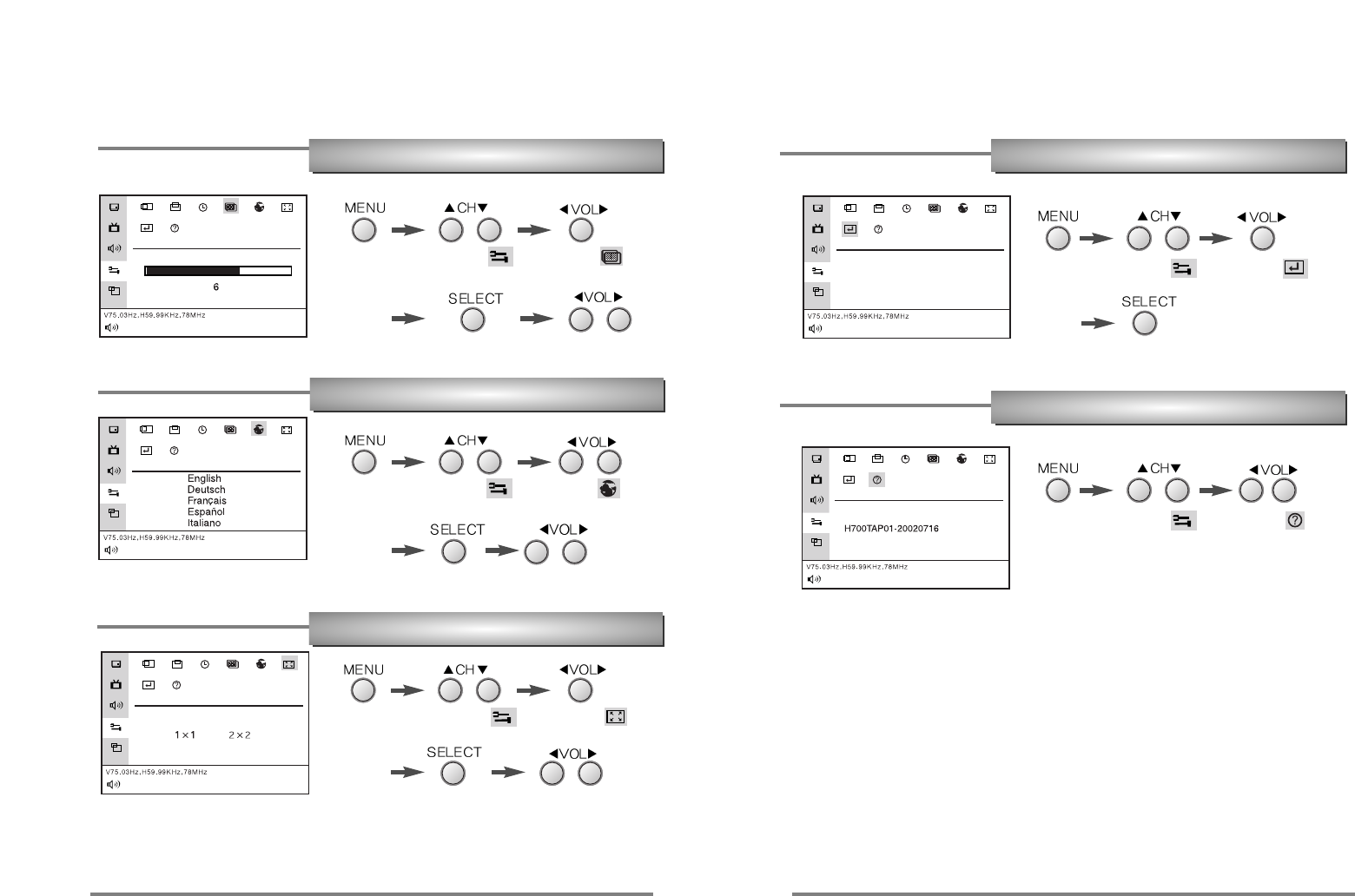
2524
OSD Overlay
Language
OSD Zoom
Factory Reset
Information
Move to Move to
Move to Move to
Move to Move to
Move to Move to
Move to Move to
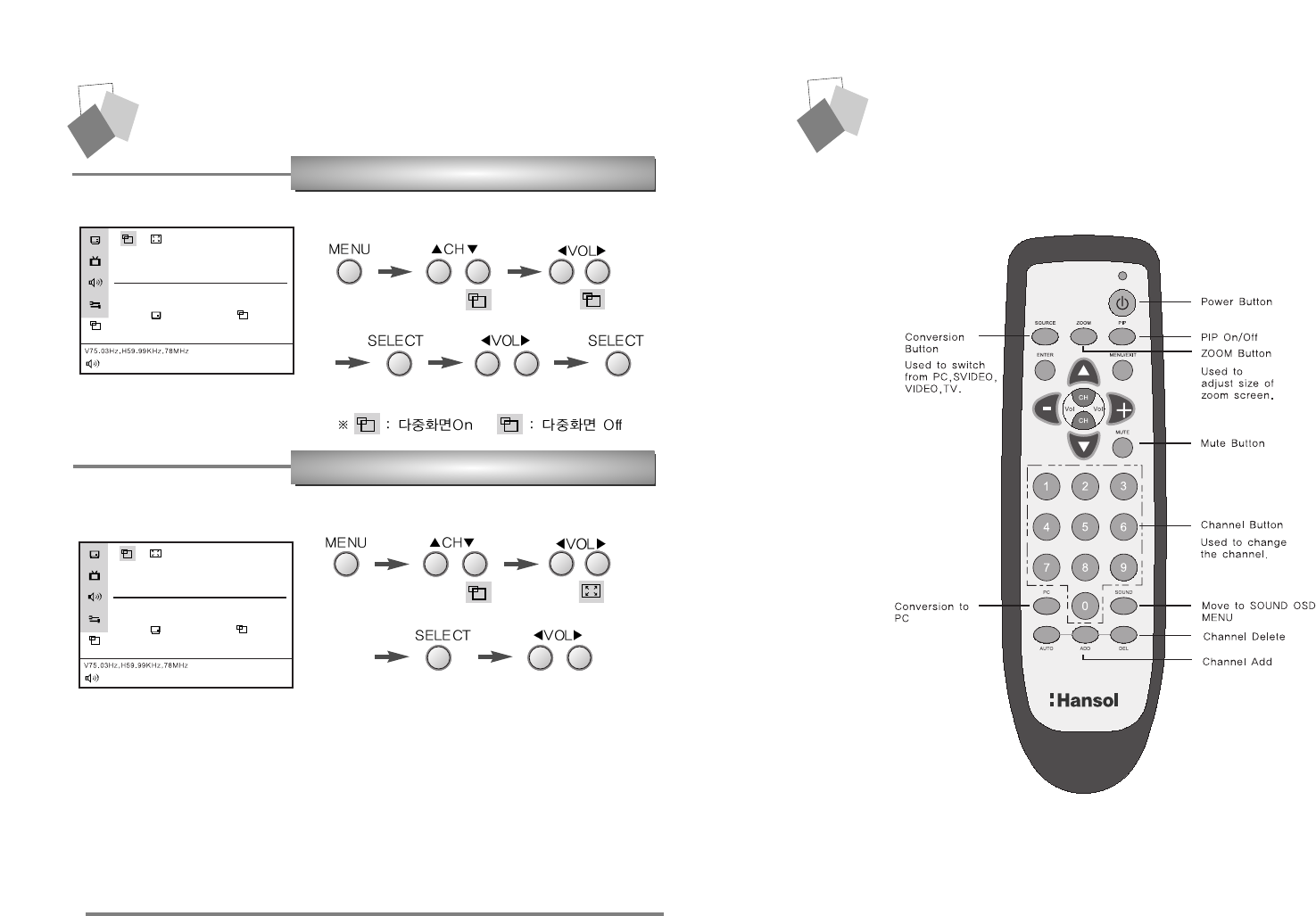
2726
PIP On/Off
PIP Position
Picture In Pincture(PIP) function Remote Controller
Move to Move to
Move to Move to
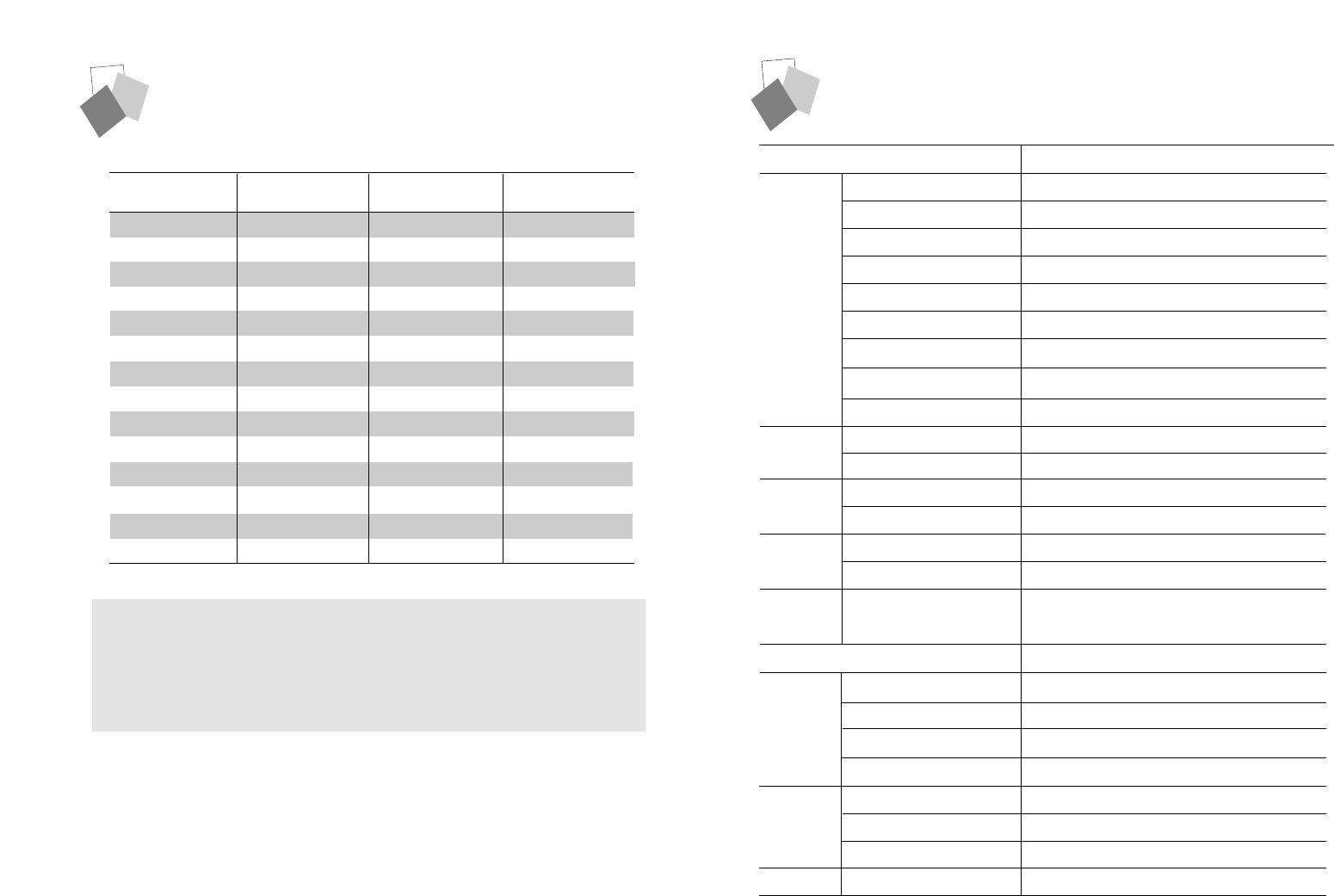
2928
Standard Signal Table
"Out of range" displayed on the screen.
This message is displayed when the signal from video card exceeds
the maximum frequency of the monitor. Readjust resolution and fre-
quency in accordance with the monitor capacity. (Refer to Standard
Signal Table)
VGA (720 X 400)
VGA (640 X 480)
VGA (640 X 480)
VGA (640 X 480)
SVGA (800 X 600)
SVGA (800 X 600)
XGA (1024 X 768)
XGA (1024 X 768)
XGA (1024 X 768)
SXGA (1280 X 1024)
SXGA (1280 X 1024)
MAC (640 X 480)
MAC (832 X 624)
MAC (1152 X 870)
31.469
31.469
37.500
43.269
46.875
53.674
48.363
60.023
68.677
63.981
79.976
35.000
49.726
68.681
70.087
59.940
75.000
85.008
75.000
85.061
60.004
75.029
84.997
60.020
75.025
66.667
74.551
75.062
28.322
25.175
31.500
36.000
49.500
56.250
65.000
78.750
94.500
108.000
135.000
30.240
57.284
100.000
Resolution
Horizontal Frequency
(KHz)
Vertical Frequency
(Hz) Clock Frequency
(MHz) Type Amorphous active matrix super TFT LCD
Screen Size 43.2cm (Diagonal)
Maximum Resolution
1280 X 1024@75 Hz
Pixel Range
0.264 mm X 0.264 mm
Maximum Colors 16.7 M
Contrast Rate 350 : 1
Visual Angle 75° / 75° / 65° / 60° (Left / Right / Up / Down)
Response Speed 25 ms
Brightness 250 cd/m2
Horizontal Frequency 80 kHz (Max.)
Vertical Frequency 85 Hz (Min.)
Video Signal Analog RGB (0.714 Vpp)
Synchronous Signal Mode H, V Separate TTL Sync,
Maximum 50 W
Power Saving Mode Under 5 W
Front Part MUTE, SOURCE, AUTO/SELECT, MENU,CH,
VOL SWITCH
Input
: 85/265V (50~60 Hz),
Output
: 12V, 5A, 60W
TV NTSC
Audio 3 Watt Speaker X 2 (Max.)
Video CVBS, S-VHS
Wall Mount VESA Standard
Safety Standard UL
EMI FCC
Low Radiation MPR-II
Size and Weight 436 X 448 X 197 / 6.3 Kg
Specification
LCD
Panel
Synchro
nization
Model H700T (B17BF)
Video
Input
Power
Consumption
Control key
Multi-
Media
Safety
Standard
& EMI
Dimension
Power Adapter
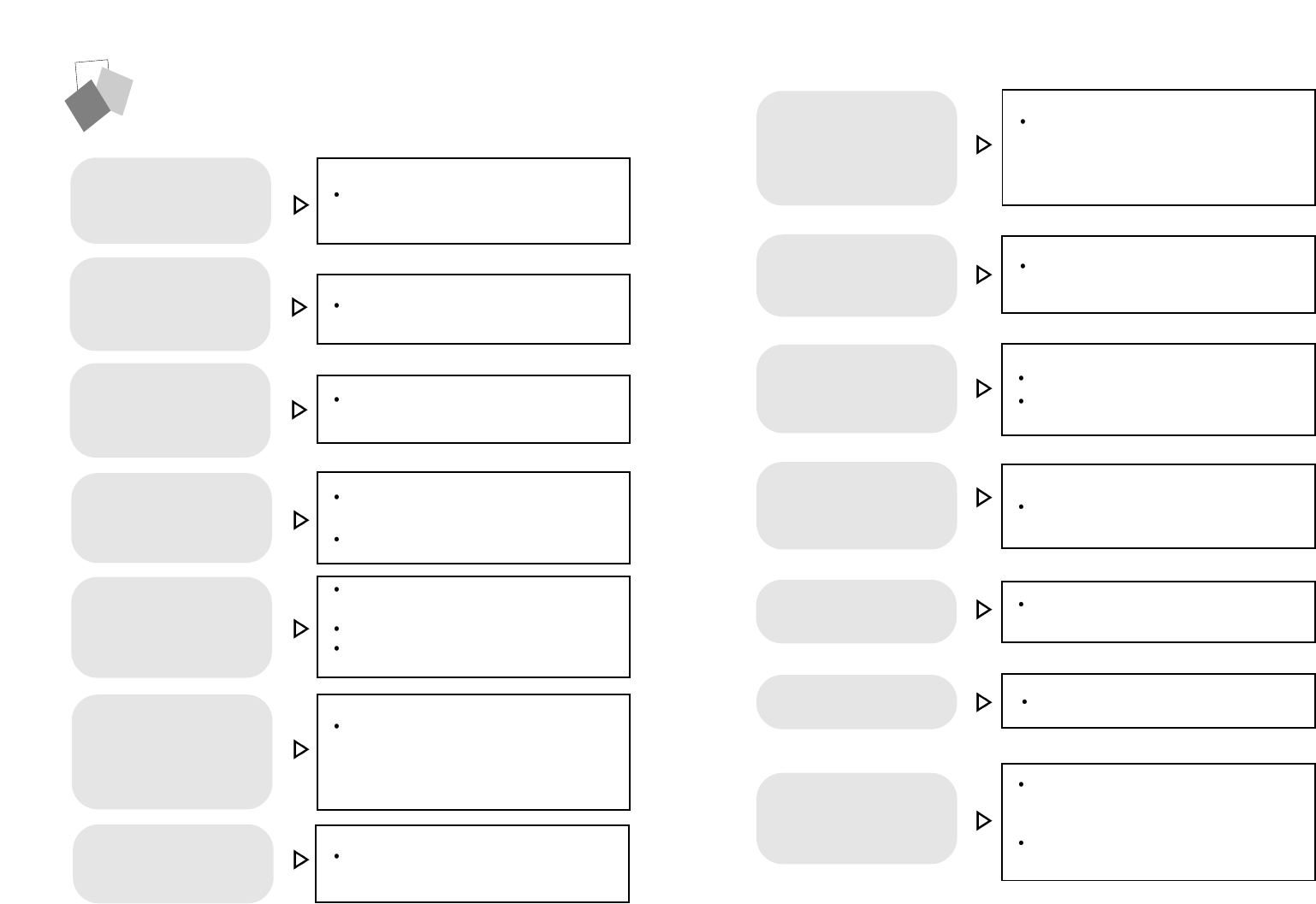
3130
Check the resolution and frequency of
computer and video card, and set up a
gain in reference to the current monitor
mode and standard signal mode table.
Double images or
'ghosts'.
Perform OSD ADJUSTMENT.
Perform AUTO ADJUSTMENT.
Adjust COLOR at User Mode in OSD Color
Menu.
Picture is dark.
Picture is biased or cut
or too wide.
Check the voice signal connection code or
adjust volume.
No sound.
Adjust BASS and TREBLE.
Dead sound.
Check if the selected channel mode is in
accordance with the channel mode of the
area.
Select AUTO SEARCH to set up the
channel automatically.
TV signal is not
received.
Monitor is in power saving mode.
Power LED turns into
amber or blinking
amber.
Troubleshooting
Check the power connection.
(Refer to page 4)
Power LED is off.
No picture.
Check the signal cable between monitor
and computer. (Refer to page 4)
Perform AUTO ADJUSTMENT.
Check if computer power is on.
Message, "Message."
is displayed on the
screen.
Check the computer connection cable.
(Refer to page 4)
Message, "No cable."
is displayed on the
screen.
Screen looks to be run
down.
Perform FREQUENCY ADJUSTMENT and
Adjust PHASE.
Switch off/on the monitor.
Remove accessories (Video extension
cable and others) and switch on.
Screen is not clear.
Check the resolution and frequency of
computer and video card, and set up the
again in reference to the current monitor
mode and standard signal mode table.
Display is unstable and
trembling.
Adjust COLOR at User Mode in OSD Color
Menu.
Color is irregular.

3332
Memo
Warning
To prevent damage or loss, please read this warning carefully.
When connecting/disconnecting the plug, pull out
the plug itself, and never pull the plug to prevent fire
caused by short.
To prevent electric shock, do not
connect/disconnect the plug with wet hand.
To prevent fire, do not connect a large number of
equipment in a single line.
To prevent fire and electric shock, pull out the plug
in case of thunder and lightening.
To prevent fire and electric shock, do not try to take
the monitor apart or repair it yourself. Contact your
local service station or customer service center for
inspection, modification or repair.
If you see smoke or smell something burning, stop
using the unit, switch off the power, pull out the plug,
and then contact your local service station.